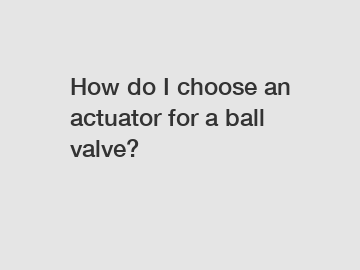How do I choose an actuator for a ball valve?
How Do I Choose an Actuator for a Ball Valve?
Choosing the right actuator for a ball valve is a crucial decision to ensure optimum performance and longevity of your valve system. With a myriad of options available in the market, it can be overwhelming to make the best choice. But fear not, as we're here to guide you through this process and help you make an informed decision.
As experienced industry professionals, we understand the importance of selecting the most suitable actuator for your ball valve. In this blog post, we will share our expertise and provide you with a step-by-step guide to help you navigate through the selection process effortlessly.

1. Understand Your Valve System:
Before you dive into the actuator selection process, it is essential to have a comprehensive understanding of your valve system. Consider factors such as valve size, pressure requirements, and media compatibility. Take note of any specific environmental conditions the actuator needs to withstand, such as extreme temperatures or hazardous substances. This understanding will lay the foundation for selecting the right actuator.
2. Determine Desired Actuator Type:
Actuators come in various types, including pneumatic, electric, and hydraulic. Each type offers unique benefits and considerations. Pneumatic actuators are commonly used due to their reliability, simplicity, and cost-effectiveness. Electric actuators, on the other hand, provide precise control and flexibility. Hydraulic actuators are known for their high force capabilities. Consider your application-specific requirements to choose the most suitable actuator type.
3. Evaluate Torque and Thrust Requirements:
Once you have determined the actuator type, it is crucial to evaluate the torque and thrust requirements of your valve. Torque requirements depend on the valve size and the pressure differential across it. Thrust requirements, on the other hand, are determined by the system pressure and the required tightness of the valve seal. Accurately assessing these requirements will ensure that the selected actuator can handle the load effectively.
4. Consider Speed and Control Options:
The speed at which the ball valve needs to open and close is another crucial factor to consider. This decision depends on the specific application requirements. Some valves may require rapid actuation, while others demand a slow and controlled operation. Additionally, consider the control options available for the actuator. Do you need a simple on-off control or proportional control? Understanding these requirements will streamline your actuator selection process.
5. Evaluate Safety Features:
Safety should be a top priority in any valve system. Actuators with built-in safety features, such as fail-safe operation or position indication, can add an extra layer of security to your system. Consider whether such features are necessary for your application, and choose an actuator that meets your safety requirements.
6. Quality and Reliability:
When it comes to choosing an actuator, never compromise on quality and reliability. Research and select reputable brands that have a proven track record in delivering high-quality products. A reliable actuator will not only ensure the smooth operation of your valve but also reduce maintenance and replacement costs in the long run.
7. Seek Expert Advice:
If you still find it challenging to select the right actuator for your ball valve, don't hesitate to seek expert advice. Consult with industry professionals and actuator specialists who can provide valuable insights and help you make an informed decision. Their expertise and knowledge will assist you in selecting an actuator tailored to your specific needs.
In conclusion, choosing the right actuator for a ball valve is a vital step in ensuring optimal performance and longevity of your valve system. By understanding your valve system, determining the desired actuator type, evaluating torque and thrust requirements, considering speed and control options, evaluating safety features, prioritizing quality and reliability, and seeking expert advice, you can confidently select the best actuator for your application.
Remember, a well-chosen actuator can significantly enhance the efficiency and reliability of your ball valve system, providing you with peace of mind and smooth operation for years to come.
Want more information on Marine Cast Bronze Valves, China 2pc body ball valve supplier, butterfly valve disadvantages? Feel free to contact us.
142
0
0


Comments
All Comments (0)